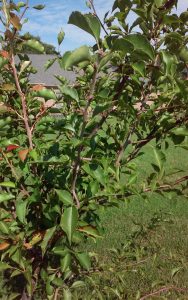Q) I had this tree volunteer in my flowerbed. I transplanted in my yard but I don’t know what it is. It does have thorns. Any info would be appreciated.
– P.P., Farmersburg, IN
A) This looks to be a seedling ornamental callery pear. For many years, the cultivar Bradford dominated the landscape and was not self-fruitful. But as newer, improved cultivars were introduced to landscapes, they were cross-fruitful with Bradford. So now “volunteer” callery pear trees are seeding themselves in alarming numbers even where they were not planted, helped along by birds. These seedling pears are extremely vigorous and quite precocious, coming into bloom and fruit at a very young age. The Indiana Invasive Species Council has listed this species as highly invasive in Indiana.
Remove seedling trees immediately or keep them mowed very low to prevent flowering and fruiting. If you have ornamental pear trees in your landscape, keep a close watch for fruit set. If your existing landscape specimens bore fruit this year, you can spray next spring with fruit inhibitor hormone (e.g., ethephon, Florel® fruit inhibitor) to reduce fruit set. Note that timing and thorough coverage is critical. The spray must be applied when plants are in the early stage of full bloom, before fruit sets. Typically, ornamental pear is in bloom for 10 to 14 days. It will be difficult to provide thorough coverage on larger specimens. Be sure to read and follow all label directions.
Better still, consider removing and replacing your ornamental pears with alternative species. Purdue has a list of alternative options for ornamental pears and other invasive landscape species. See Extension publication ID-464, “Alternative Options for Invasive Landscape Plants.”
More information about these invasive pears:
Official Indiana Invasive Species Council Invasive Plant List
